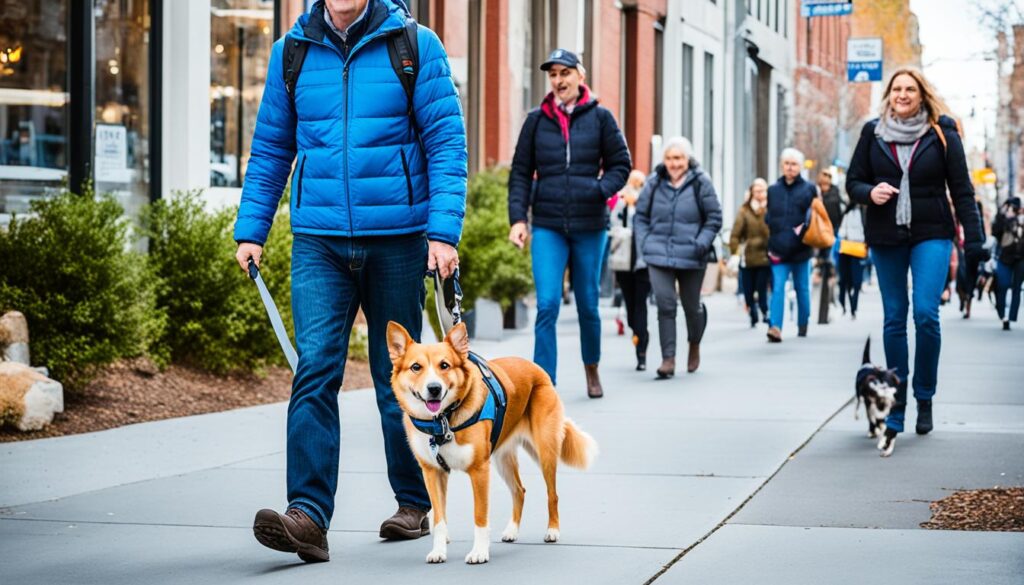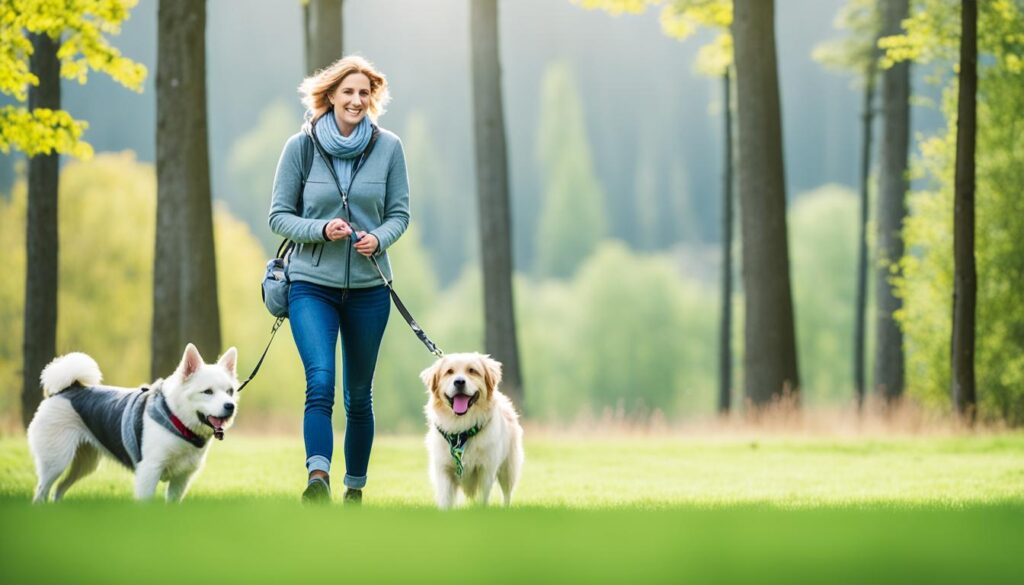Dog leash training is an essential skill that every dog owner should master. It not only ensures your dog’s safety but also promotes good behavior and control in various environments. Whether navigating busy streets, exploring dog parks, or hiking on trails, leash training is crucial for a harmonious and enjoyable experience. This article will explore different techniques and strategies for leash training in different environments to help you and your furry friend have a positive walking experience.

Key Takeaways:
- Leash training is essential for the safety and control of your dog in various environments.
- Adapting leash training techniques to different settings helps ensure obedience and good behavior.
- Techniques like the “Look at That” game and planned distractions can help dogs stay focused in urban areas.
- Controlled training zones and teaching the “heel” command are essential for walking on busy streets and sidewalks.
- Establishing leash work before play and reliable recall is crucial in dog parks and natural settings.
- Proper leash training in hiking trails includes managing terrain and teaching the “leave it” command.
Dog Leash Training in Different Environments
Leash training is not a one-size-fits-all approach. It requires adapting to different environments and distractions. This section will delve into the specifics of leash training in various settings, including distracting neighborhoods, busy streets and sidewalks, dog parks, and hiking trails. By understanding the unique challenges and techniques required for each environment, you can ensure that your dog walks obediently and safely wherever you go.
Regarding leash training in different environments, it’s essential to consider the specific distractions and challenges you may encounter. In distracting neighborhoods, for example, your dog may be exposed to loud noises, other dogs, and busy streets. You must implement leash control skills and techniques to keep your dog focused and well-behaved.
In busy streets and sidewalks, creating controlled training zones can be beneficial. These zones allow you to gradually expose your dog to the stimuli of urban environments while maintaining control and ensuring their safety. Teaching the “heel” command is also essential for keeping your dog by your side and preventing them from darting into traffic.
When visiting dog parks, it’s essential to establish leash work before play. Balancing freedom and control is critical to maintaining a safe and respectful environment for all dogs. Additionally, having a reliable recall is crucial so that you can call your dog back to you when necessary.
Hiking trails allow dogs and their owners to enjoy nature and outdoor adventures. However, leash training is still essential to ensure your dog’s safety and preserve the natural environment. Managing different terrains and encounters with wildlife requires specific leash control skills, and teaching the “leave it” command can prevent your dog from disturbing or harming the surroundings.
You can ensure that your dog walks obediently and safely by tailoring your leash training techniques to different environments.
Distracting Neighborhoods
Leash training in urban settings can be challenging due to the numerous distractions that dogs encounter, such as loud noises, other dogs, and busy streets. However, with the proper techniques and strategies, you can help your dog stay focused and well-behaved during walks in these environments.
Mastering the “Look at That” Game in Urban Settings
The “Look at That” game is a valuable technique for desensitizing dogs to distractions in urban settings. It involves teaching your dog to focus on you when encountering something that typically triggers their attention. When your dog sees something distracting, say, “Look at That”, and reward them with a treat or praise when they shift their attention back to you. This game helps them associate distractions with positive rewards and reinforces their focus on you.
Planned Distractions
Incorporating planned distractions into your leash training sessions can help your dog develop resilience and self-control. Gradually introduce controlled distractions like toys, people walking by, or other dogs while practising obedience commands. Start with low-level distractions and progressively increase their difficulty as your dog becomes more accustomed to distractions. This process helps build their impulse control and teaches them to focus on you despite the distractions around them.
Implementing Redirection Techniques Amid Distractions
Redirection techniques are essential for maintaining control and obedience during leash training in distracting neighborhoods. When your dog becomes fixated on a distraction, use a verbal cue or gentle leash tug to redirect their attention back to you. Reward them for complying with the redirection and reinforce the behavior. It’s essential to be patient and consistent when implementing redirection techniques, as it may take time for your dog to learn to shift their focus from distractions to you.
Mastering the “Look at That” game, incorporating planned distractions, and implementing redirection techniques will help your dog build the necessary leash control skills and become well-behaved in distracting neighborhoods.
Adapting Leash Training Techniques to Busy Streets and Sidewalks
Walking on busy streets and sidewalks can present unique challenges for leash training. It requires a combination of control, focus, and adaptability to ensure the safety and well-being of your dog. In this section, we will explore practical techniques for leash training in urban environments, including using controlled training zones and teaching the “heel” command. Additionally, we will highlight the importance of awareness and provide valuable leash training tips for navigating busy streets and crowded sidewalks.
Controlled Training Zones
Creating controlled training zones is crucial for successful leash training on busy streets and sidewalks. These zones offer a controlled environment where you can gradually expose your dog to urban settings’ various distractions and stimuli. Start by selecting a slightly quieter area with moderate foot traffic. You can introduce progressively more challenging and busier locations as your dog becomes more comfortable and adept at walking in this controlled zone.
Using a secure and reliable leash is essential when establishing a controlled training zone. Avoid retractable leashes, as they give your dog too much freedom and make it difficult to maintain control in crowded areas. Opt for a sturdy, 4-6-foot leash that allows you to guide and redirect your dog effectively.
Teaching “Heel” With Safety in Mind on Bustling Paths
The “heel” command is essential for leash training on busy streets and sidewalks. Teaching your dog to walk calmly and attentively by your side enhances safety and promotes good behavior in public spaces.
Hold a treat or toy close to your body and stroll. Encourage your dog to walk beside you using the verbal cue “heel” and reward them with praise and a treat when they remain by your side. Be patient and consistent with your training, gradually increasing the duration and distance of the “heel” command.
When walking in bustling areas, being mindful of your surroundings and anticipating potential distractions is crucial. Keep a relaxed but firm grip on the leash, controlling your dog’s movements. Use verbal cues and gentle leash guidance to redirect your dog’s attention back to you if they show signs of becoming distracted or anxious.
Awareness is Key
Developing a strong sense of awareness is essential when leash training on busy streets and sidewalks. Pay close attention to your dog’s behavior, body language, and environment. This heightened awareness will enable you to anticipate potential challenges and respond appropriately.
Avoid potential hazards such as moving vehicles, cyclists, or other dogs. Use your voice and body language to communicate with your dog and guide them through challenging situations. Remember to reward and praise your dog for their excellent behavior and attention, reinforcing positive leash control skills.

Implementing these leash training techniques and tips ensures your dog walks safely and obediently on busy streets and sidewalks. With patience, consistency, and a focus on awareness, you and your furry friend can confidently navigate urban environments and enjoy the benefits of a well-behaved walking companion.
Leash Training Tips for Busy Streets and Sidewalks
1. Create controlled training zones to expose your dog to urban distractions gradually.
2. Use a secure and reliable leash for better control in crowded areas.
3. Teach the “heel” command to encourage your dog to walk calmly by your side.
4. Be aware of your surroundings and anticipate potential distractions or hazards.
5. Use verbal cues and gentle leash guidance to redirect your dog’s attention.
Leash Etiquette and Control in Dog Parks and Natural Settings
Dog parks and natural settings provide opportunities for dogs to socialize and explore. However, maintaining leash etiquette and control is crucial for a safe and pleasant experience for your dog and others. This section will discuss essential aspects of leash training in dog parks and natural settings, including the balance between freedom and control and the significance of a reliable recall.
Leash Work Before Play: Balancing Freedom and Control
Before allowing your dog off the leash to play and explore, it is essential to establish a solid foundation of leash control. This ensures your dog understands the boundaries and expectations even in off-leash areas. You can reinforce positive behaviours and maintain control during walks and playtime by practising leash skills and commands in a controlled environment, such as a designated training zone.
During leash training, teach your dog to consistently walk calmly beside you and respond to commands. Use positive reinforcement techniques, such as treats and praise, to reward good behavior. Gradually increase distractions and freedom as your dog becomes more proficient in leash control skills.
Remember, finding the right balance between freedom and control is the goal. Your dog should enjoy the freedom to explore, interact with other dogs, and sniff around while respecting boundaries and responding to your commands.
Reliable Recall is Crucial
A reliable recall is one of the most critical commands for off-leash activities in dog parks and natural settings. It ensures your dog returns to you promptly and obediently, even when distractions occur. A strong recall command can prevent your dog from getting into potentially dangerous situations or causing inconvenience to others.
When training a recall command, start in a quiet, familiar environment with minimal distractions. Use a consistent verbal cue, such as the word “come” or “here,” paired with positive reinforcement, such as treats or toys, to motivate your dog to return to you. Gradually increase the level of distractions as your dog becomes more reliable in responding to the recall command.
Practising the recall command regularly is essential, even after your dog has mastered it. This helps maintain their responsiveness and reinforces the importance of returning to you when called.

By establishing leash work before play and ensuring a reliable recall, you can have peace of mind knowing that your dog can enjoy the freedom of off-leash activities while remaining under control. These leash training tips will help you create a positive and safe experience in dog parks and natural settings.
Hiking Trails
Hiking trails allow dogs and their owners to explore nature and enjoy outdoor adventures. However, proper leash training is necessary to ensure safety and respect for the environment.
Hiking Trail Manners: Managing Terrain and Wildlife Encounters
When hiking with your dog, following hiking trail manners is essential to maintain a positive experience for everyone. Be mindful of the terrain and stay on designated trails to avoid damaging the surrounding environment. Please always keep your dog on a leash to prevent them from disturbing wildlife or venturing into restricted areas. By practising good hiking trail manners, you can help preserve the natural beauty of the trails and ensure a harmonious hiking experience.
“Leave It” Command
Teaching your dog the “leave it” command is crucial for their safety on hiking trails. This command ensures your dog does not pick up or ingest potentially harmful substances or encounter dangerous wildlife. By training your dog to respond to the “leave it” command, you can prevent accidents and keep them safe during your outdoor adventures. Practice the command regularly during leash training sessions and reinforce it with positive rewards to establish a robust and reliable response.
Conclusion
Leash training is an ongoing journey that requires patience, consistency, and adaptability. By understanding the specific challenges and techniques for leash training in different environments, you can ensure that your dog walks obediently, safely, and with good manners.
Each environment presents its challenges, and it’s essential to tailor your approach accordingly.
Prioritizing your dog’s safety and well-being is critical to successful leash training. By investing time and effort into leash training, you teach your dog valuable control skills and build a solid bond between you and your furry companion.
FAQ
Why is leash training essential?
Leash training is essential because it ensures your dog’s safety and promotes good behavior and control in different environments.
What are some leash training techniques for distracting neighborhoods?
Some leash training techniques for distracting neighborhoods include playing the “Look at That” game to desensitize your dog to distractions and implementing planned distractions and redirection techniques to maintain control.
How can I adapt leash training techniques to busy streets and sidewalks?
To adapt leash training techniques to busy streets and sidewalks, create controlled training zones to gradually expose your dog to distractions, teach the “heel” command for walking calmly and safely, and prioritize awareness during walks.
What leash etiquette and control should I practice in dog parks and natural settings?
In dog parks and natural settings, establish leash work before play to maintain control, balance freedom and power, and ensure a reliable recall for your dog’s obedience.
How can I practice leash training on hiking trails?
When practising leash training on hiking trails, focus on managing terrain and wildlife encounters, and teach your dog the “leave it” command to respect the natural environment.

